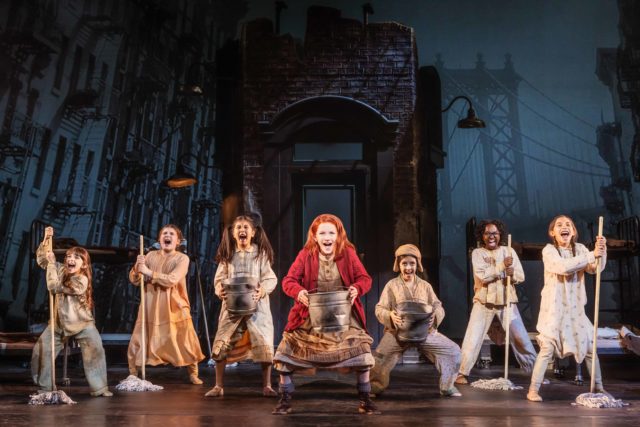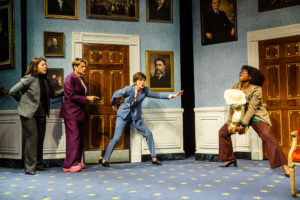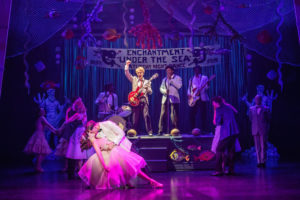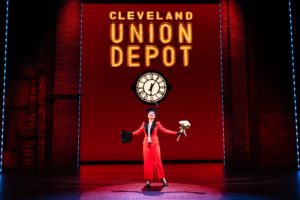This post was updated May 13 at 7:47 p.m.
For “Annie,” the sun is not coming out much.
Broadway’s beloved orphan has settled in Los Angeles for a brief run at Hollywood’s Dolby Theatre until May 18. The classic production, which won the Tony Award for Best Musical in 1977, follows the titular 11-year-old (Hazel Vogel) on a mission to find the parents who abandoned her in Great Depression-struck New York City. For lovers of iconic show tunes like “Tomorrow” – or perhaps fans of 2014’s film adaptation starring Jamie Foxx – “Annie” delivers a pleasant evening of nostalgia and charm. But truthfully, with unremarkable performances, unambitious sets and an uncomfortable swell of American spirit, the musical isn’t exactly a must-see on LA’s current theater slate.
“Annie” opens on a dull note, though it is somewhat intentional. Setting the stage in the New York Municipal Orphanage, dim lights and rugged beds convey the bleakness of life for the girls under Miss Hannigan’s (Stefanie Londino) authority. Costume designer Alejo Vietti excels in his use of color, placing the orphans in muted rags that later contrast the vibrance of the city. However, Wilson Chin’s scenic design is fairly boring, featuring a lone door frame in front of a zoomed-in, solid-colored image of a New York street. Throughout the show, Chin’s work fails to fully immerse the audience, relying primarily on still backdrops with slightly wonky perspectives.
Unfortunately, the musical’s first big number, “It’s the Hard Knock Life,” doesn’t alleviate these disappointments as much as one might hope. The orphans’ routine isn’t fully polished, with loud vocals and jumbled prop use toeing the line between endearingly youthful and mildly annoying. Nonetheless, the ensemble of children shines bright when it comes to attitude, and their comedic chops especially hook the audience in subsequent scenes, where they can play off of the dramatic Miss Hannigan.
[Related: Theater review: While lacking good script, ‘Harry Potter and the Cursed Child’ spurs magic onstage]
Among her peers, Vogel is a natural fit for Annie, perfectly capturing her everlasting optimism and mature sense of spunk. But it is also worth noting that her belting takes on a more piercing, whiny effect in her numerous solos, often pulling viewers out of the emotional context in songs such as “Maybe” and “Tomorrow.” Harping on an evidently gifted child actress feels unkind, though it’s a fair point to consider with ticket prices ranging from $60 to more than $170.
Luckily, later in Act One the show rises to its best heights, largely because of the star power from Londino, Christopher Swan as Oliver Warbucks and the versatile adult ensemble. While Londino’s drawn-out line delivery can feel repetitive at times, her physicality sends viewers into fits of laughter, and she is deliciously villainous in a way they can’t look away from. The arrival at Warbucks’ mansion marks another high performance point, as “I Think I’m Gonna Like It Here” boasts angelic harmonies and clean kicklines derivative of traditional Broadway.
Perhaps the strongest number in the act is the penultimate “Easy Street,” in which Hannigan joins forces with her brother Rooster (Rhett Guter) and his girlfriend Lily (Isabella De Souza Moore) to use Annie for riches. There is absolutely no reason to root for the scheming trio, but their performance is smooth and alluring enough to distract from their lack of morals. Brilliantly executing the jazzy choreography and taking full advantage of every comedic beat, the three actors boldly remind audiences that they paid for a professional show.
[Related: Theater review: ‘Furlough’s Paradise’ embrace of intimacy through script, set design moves viewers]
After the intermission, however, “Annie” gets cloudy again. The story’s riveting climax is surrounded by a lot of unnecessary moments, including a lengthy radio show and an awkward waltz between Annie and Warbucks. Yet the strangest point of all is an entire subplot that takes place in the White House with President Franklin D. Roosevelt (Mark Woodard), who for some reason is an integral character. In a scene that takes place in front of a wide American flag and absolutely no other defining features of the White House, Annie more or less inspires Roosevelt to enact the New Deal by singing a song to his administration – a regular day in American politics.
And the very last song in “Annie” is not a ballad about finding family or staying determined or any other key theme in the two-and-a-half-hour show. Instead, the cast sings “New Deal for Christmas,” celebrating the work of Roosevelt – largely unrelated to Annie’s big journey. The joy of Annie’s adoption is shadowed by this out-of-place American spirit, which was probably more appealing when the musical first debuted.
A synopsis of “Annie” on the Broadway in Hollywood website describes this touring production as arriving “just when we need it most.” By the end of the musical, that tagline doesn’t feel very accurate. Annie’s positive attitude is certainly inspiring, but it only works within a well-executed show, and this unfortunately fails to deliver. On top of the bizarre, untimely patriotism, audiences will ultimately leave the Dolby without the orphan’s same sense of brightness.
But even with its shortcomings, it doesn’t hurt to be optimistic – maybe “Annie” will be better “Tomorrow.”








Comments are closed.